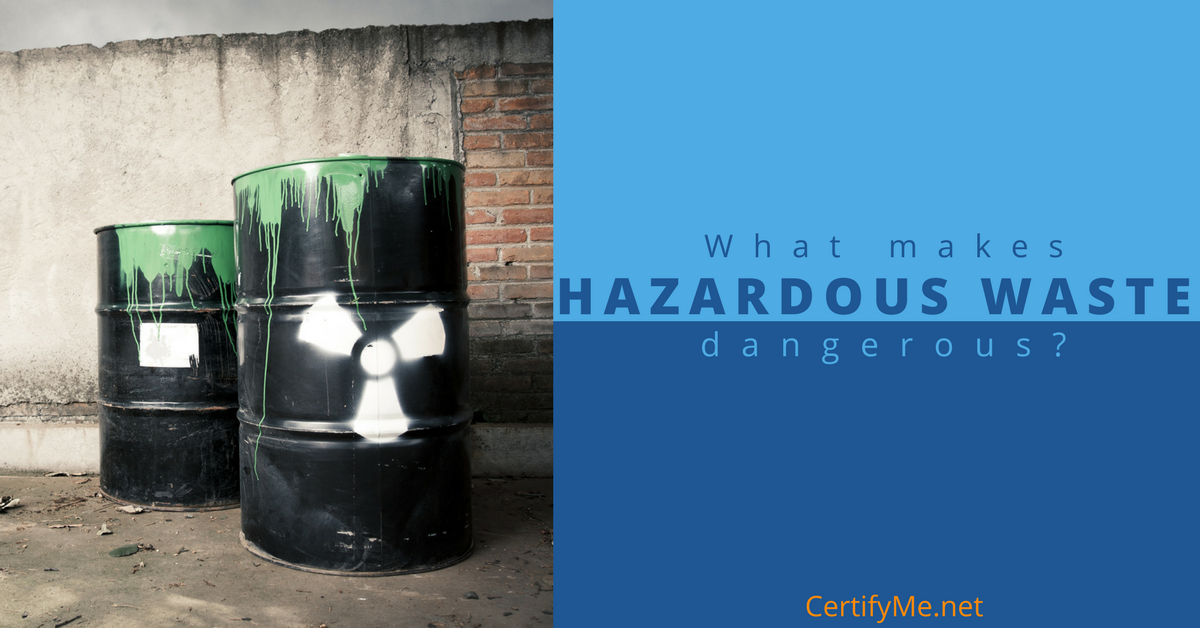What Workers Need to Know About Hazardous Waste
Posted by: admin on January 10, 2022
 It may seem surprising, but you are most likely around a wide variety of hazardous waste on a daily basis. Everyday items like batteries, mercury-contacting equipment like thermostats, and asbestos insulation and floor tiles are all considered hazardous waste that has the potential to harm human health.
It may seem surprising, but you are most likely around a wide variety of hazardous waste on a daily basis. Everyday items like batteries, mercury-contacting equipment like thermostats, and asbestos insulation and floor tiles are all considered hazardous waste that has the potential to harm human health.
For professionals who work in construction, maintenance and disposal/removal work, it is especially imperative to learn how to identify hazardous waste, how to respond to positive findings, how to remove it properly, and how to protect your health.
What Exactly is Hazardous Waste?
Hazardous waste is the term used to describe any substance with harmful or dangerous properties. In movies and on TV, it’s often depicted as a mysterious, oozing green liquid. In reality, hazardous waste is often far more difficult to identify. It can be a liquid, solid, or gas, and can even be invisible to the eye. It can also be by-products of manufacturing processes like discarded materials and discarded unused commercial products like cleaning fluids and pesticides.
What Are the Characteristics of Hazardous Waste?
Ignitability, corrosivity, reactivity, and toxicity are all dangers of hazardous waste. Ignitability includes liquids with a flashpoint below 60-degree Celsius, non-liquids that can cause fire through specific conditions, and ignitable compressed gases and oxidizers.
Corrosivity means that a liquid can corrode steel. It also includes aqueous wastes with a pH score of less than or equal to 2, or a pH greater than or equal to 12.5.
Reactivity wastes are hazardous because they can react or become unstable under normal conditions, like coming into contact with water, giving off toxic gases, or exploding under normal conditions or when heated.
Toxicity includes wastes that have toxic properties and are harmful when ingested or absorbed. They are dangerous because they can leach from waste and pollute groundwater.
Types of Hazardous Waste
Understanding the dangers and proper disposal methods of these substances starts with a thorough understanding of the hazardous waste definition. The Environmental Protection Agency has defined four main types of hazardous waste. The F-List wastes stem from unspecified sources but are produced by manufacturing and industrial processes. Hazardous waste examples on this list include things like petroleum refinery wastewater treatment sludges and wood-preserving waste.
K-list waste, on the other hand, is more source-specific. Ink formulation and pesticide manufacturing are two of the most common causes of K-list hazardous waste. P-list and U-list waste are commercial chemical products that must be disposed of but are unused.
Universal hazardous waste is another important category to know about. These are generated by the public at large and include things like batteries and thermometers. Mixed waste, on the other hand, contains both hazardous and radioactive components. Many of the dangers of hazardous waste lie in the public’s misconception about how to dispose of such material.
While the details of specific types of hazardous waste might seem overwhelming at first glance, it’s important that forklift operators understand the differences between these varieties and know how to properly dispose of them. Even if you don’t anticipate interacting with hazardous waste materials on a daily basis, it’s crucial to learn how to handle and dispose of things like forklift batteries so you’re not risking your health or the health of others.
How is Hazardous Waste Removed and Disposed of?
 The first part of disposing of hazardous waste is first identifying it. Waste removal personnel should ask these four questions to correctly determine if a waste meets the RCRA definition of hazardous waste:
The first part of disposing of hazardous waste is first identifying it. Waste removal personnel should ask these four questions to correctly determine if a waste meets the RCRA definition of hazardous waste:
- Is the material a solid waste?
- Is the waste specifically excluded from the RCRA?
- Is the waste a listed hazardous waste?
- Does the waste exhibit a characteristic of hazardous waste?
Review section 40 CFR part 261 on the Government Federal Regulations website for full explanations of these questions and answers.
Once the waste has been identified, removing it correctly will be very important to avoid any potential health risks and disturbing the surrounding environment.
OSHA’s decontamination plan that every worker should follow before entering a work site where there may exist the potential for exposure includes:
- Determining the number and layout of decontamination stations
- Determining the necessary decontamination equipment and methods
- Establishing procedures for preventing contamination of clean spaces
- Establishing methods to minimize worker contact with contaminants
- Establishing methods for disposing of clothing and equipment used during the removal process that are not completely decontaminated
To prevent contamination, personnel should avoid work practices that increase contact with hazardous waste, use remote sampling and handling, protect monitoring and sampling tools through bagging, wear disposable clothing and disposable equipment when possible, cover equipment and tools with disposable coating, and encase the source of contamination with plastic sheeting or overpacks. Personal protective equipment (PPE) must be given to all workers free of cost before beginning work in an area contaminated with hazardous waste.
Decontamination and removal methods typically involve physical removal and chemical removal.
Physical removal involves dislodging or displacing, rinsing, wiping off, and evaporation of contaminants. Physical methods can also involve high pressure and heat to remove hazardous waste.
The types of contaminants that can be removed by physical methods include:
- Loose contaminants– dusts, vapors, and electrostatically attached materials
- Adhering contaminants– substances that stick to materials like glues, cement, resins, and muds
- Volatile liquids– removed by water rinsing or evaporation through steam jets
The chemical removal of hazardous contaminants typically follows physical removal and involves cleaning solutions. It involves these methods:
- Dissolving contaminants– dissolving chemicals in a solvent
- Surfactants–reduce the adhesion forces between contaminants and the surface being cleaned
- Solidification– solidifying liquid or gel substances to make it easier to physically remove them
- Rinsing– removing contaminants through dilution, physical attraction, and solubilization
- Disinfection/sterilization– chemical disinfectants to deactivate chemical substances
The Dangers of Hazardous Waste
Without proper removal and decontamination methods, workers, citizens, and the environment are put at risk of exposure and toxicity from hazardous wastes. Chemicals and asbestos materials have respiratory illness and cancer-causing properties for humans. Hazardous waste can seep into the ground and contaminate the soil from which food is grown and leach into the groundwater from which people drink. The proper identification and disposal of hazardous waste is not only imperative during the removal process for workers involved, but also for the entire community in the long-term.
HAZWOPER Training from CertifyMe.net Keeps Workers Safe
HAZWOPER stands for the Hazardous Waste Operations and Emergency Response Standard and is essential for workers and employers involved in clean-up operations involving hazardous waste, corrective actions involving clean-up operations, voluntary clean-up operations at uncontrolled hazardous waste sites, operations involving the treatment, storage and disposal of hazardous waste, and emergency response operations for release of hazardous waste.
The OSHA-compliant HAZWOPER training course from CertifyMe.net will help your business comply with industry regulations and keep your workers safe. It teaches all employees involved in hazardous waste management, including forklift operators, how to properly identify, manage, and remove hazardous substances. We offer 40-hour initial HAZWOPER training and 8-hour refresher HAZWOPER training courses both online for convenience and stress-free learning.
Learn more about our OSHA-compliant and comprehensive HAZWOPER training and forklift operator training courses on our website or by calling (888) 699-4800. You can also visit our contact page to ask a question, get a quote and more.
Welcome to CertifyMe.net
CertifyMe.net has offered online forklift certification since 1999. With Our Convenient online program. your employess can earn their certification in an hour or less.
Browse Online Certifications:
This low-cost program can be compeleted anytime, anywhere!






